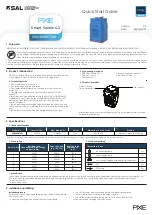
Operations Manual
113
A BUS must always exist in the Emulated LAN and all LECs must join its
distribution group.
In an SVC environment, the BUS needs to participate in the LE Address
Resolution Protocol (LE_ARP) to enable a LEC to locate the BUS. The BUS
also handles ATM connections and manages its distribution group.
Once a LEC has successfully joined an ELAN, it will request the LES with
the BUS address to set up a connection to the BUS. If it loses this connection,
it has to rejoin the ELAN. If it receives a packet with a multicast or
broadcast MAC (group) address, the LEC sends the packet to the BUS which
forwards it to all the other LECs in the ELAN.
A BUS is the multicast server for an ELAN. It handles all broadcast,
multicast and unknown unicast traffic. Packets to be broadcast from the LEC
are sent to the BUS. The BUS then sends the packets back to all the LECs
using the point-to-multipoint connection.
LECs also send packets with unknown destinations to the BUS. The BUS
forwards these packets to every LEC on the ELAN, including the source
LEC where the packet originated.
In the meantime, the LEC also sends an ARP request to the LES for address
resolution. After the associated ATM address is resolved, the LEC sets up a
data direct VCC to carry the traffic. After the data VCC is set up the
following data to the destination address will be forwarded via the data VCC
instead of the BUS.
LAN Emulation Configuration Server (LECS).
The primary function
of the LECS is to provide LES addresses to the LECs.
















































